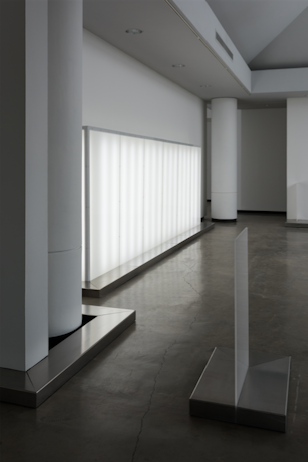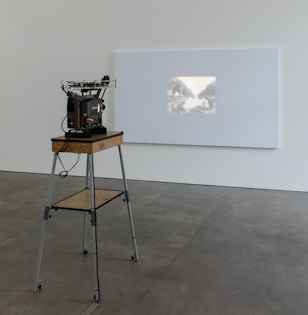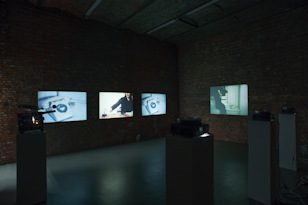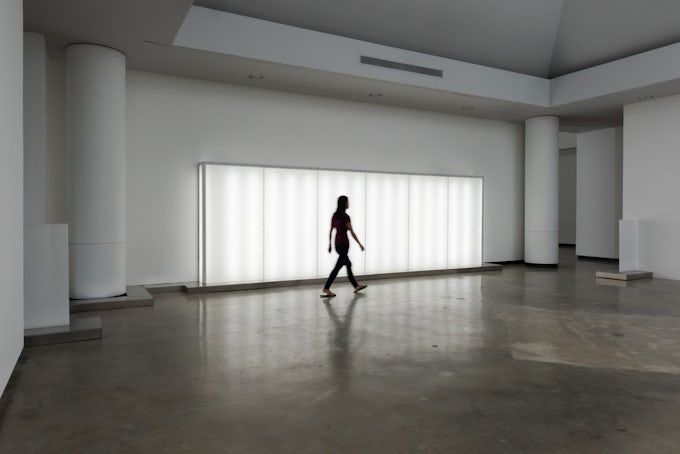
For more than fifty years, David Lamelas’s work has explored questions of time, space and language. Born in Buenos Aires, but having lived and worked in Europe and the United States since the late 1960s, his own experience of dislocation has shaped a diverse body of work, which remains unbound by any particular location or medium. Working across sculpture, installation, photography and film, his art explores the management of cultural and institutional space. Early sculptural works such as Dos espacios modificados (Two Modified Spaces, 1967) explore the syntax of exhibitions, to transform them and disrupt the viewer’s expectations and behaviour; whereas ongoing series such as Time as Activity (1969–ongoing) meld time and space, presenting observational portraits of different cities through static camera positions, as he explains here: ‘to create a time capsule … within my time, the time of a film reel. The spectator is just watching time passing.’
Neus Miró: I would like to start with your earliest works, which were in sculpture, but very soon evolved into experiments with the exhibition space.
David Lamelas: For me that evolution was very simple. I was never a classical sculptor: I always questioned the idea of sculpture, and the idea of dematerialisation of the sculptural process appealed to me very much. That is how I started to work with light; like the cone piece [Limit of a Projection I, 1967] and with Situation of Time [1967], and this is how I began working with the media, like with the news’ room piece about the Vietnam war [Office of Information about the Vietnam War at Three Levels: The Visual Image, Text and Audio, 1968].
I always used the space where I presented my works, since my very first show, which was in a very small gallery in Buenos Aires called Carlos Gardel. I had three large walls and I made three large paintings in response to the sizes of the walls.
NM: There’s a work you did in 1966 called Connection of Three Spaces that I believe is very relevant to your use of the exhibition space itself.
DL: That was a site-specific installation where the piece happened in three different rooms. When you view a sculpture you view it in one moment and I wanted it to be like a book or like a film, that the work becomes a mental construction, so the installation started in one room moved into the next room across the wall, let’s say, and across the wall into the third room. So the piece could only exist in its totality in one’s mind.


NM: You were interested in its unfolding in time.
DL: In time, in memory and it made the spectator active. You construct the piece.
NM: Were you aware of expanded cinema practices – Nam June Paik, Malcolm Le Grice, for example, among many others?
DL: Oh, no, I was in Argentina at that time and I was very young, I was 16 or 17. I was not very cultured at all. I had not yet been to New York or London so didn’t know of those practices. When I was in Argentina I was familiar with experimental cinema, with the movies of Jean-Luc Godard, of Andy Warhol. I remember going to the cinema as a child, and one of the things that fascinated me was the light travelling from the projection booth to the screen. My first works with light were an attempt to replicate that fascination, rather than an intellectual exercise. I was fascinated with that magic trick; the images were transported by that light. It was more linked to my childhood memories rather to other contemporary artists’ practices.
NM: Tell me about your interest in the systems of communication, such as television, at that time.
DL: I arrived there through a different channel than most artists. It was because the Instituto Torcuato of Di Tella [in Buenos Aires] was sponsored by the biggest manufacturer of television sets in Argentina, so one of the ideas was to show their products in the art space. They also produced refrigerators and washing machines – it was the equivalent to General Electric in Argentina. I was working with light and I was interested in the new media, as many others at that time, influenced by McLuhan’s texts, and I had always been interested in the manufacturing of the news, how the news was produced. This evolved into the exhibition of the piece with the TV sets [Situation of Time, 1967] – they are shown, however, as a piece of sculpture, as a primary structure, and installed like a minimal sculpture, there was the same gap in between the TV sets and there was no image on the screen, the idea was to show the channel of information empty of information, to show the void.
NM: And the piece you made for the Venice Biennale in 1968, Office of Information, was transmitting the news from Vietnam.
DL: I was interested in the travelling of information, and Vietnam news was the most important news at that time.
NM: You have re-enacted that piece on several occasions throughout the years, and most recently at MoMA you opted for having the same magnetophon, the same table, the original telex transcriptions, etc. If the transmission of news as it happened was at the core of that piece, how would the piece be adapted to a current situation?
DL: At MoMA we decided to use the originals, that was a decision made by the curators and I’m very happy that we did it. In 1968, it was the same – we got the news for the first week and for the following days the information was repeated. However, at MoMA they acquired a new meaning; when I first showed it at Venice it was just a piece of information, I was quite detached – whereas now I was very impressed by it, by its human side.
NM: That travelling of information relates to your work A Study of the Relationships Between Inner and Outer Space, produced for the exhibition titled ‘Environments Reversal’ at Camden Arts Centre in 1969. Can you talk about that exhibition and how that piece came about?
DL: The curator at the time at the Camden Arts Centre was Peter Curry. There were about ten artists [invited to exhibit at ‘Environments Reversal’], and when I was invited to the show I mentioned that I wanted to make a film. It was the only film in the show. I wanted to make a film that started in the Camden Arts Centre, in the actual gallery where it was going to be projected, which would gradually expand into a sequence of spaces in London (Royal Mail, London Underground…). It was about means of communication.

NM: How was it presented in the exhibition?
DL: It was shown in a gallery on its own. I wanted to have it screened, like in a cinema, so we painted the gallery black, installed a screen, chairs, and the film was projected every hour. The work was not really integrated into the exhibition because it was film, and film was something that was not part of an art show. In those days film was the ugly ducky in the exhibition. Also in 1969 I showed Time as Activity, on its own with a 16mm projector, as part of the exhibition ‘Prospect 69’. Again, it was the only film in the exhibition; the other pieces were sculptures or other types of work, for instance, by Richard Long, Joseph Beuys, Bruce Nauman and Marcel Broodthaers. Showing film as part of an exhibition started soon after those years, but it was not yet part of it then. It was a bit frustrating. Some people didn’t take my work as work, they would pop in for a second and would leave. It took a long time for people to evolve and accept it.
NM: So, people would not stay to watch the film back then either.
DL: Oh, they never stay [laughs].
NM: You started Time as Activity in 1969 in Düsseldorf and then you returned to that idea much later in 2004 and in following years. What was your interest in time back then?

DL: I was interested in cinema and cinema is about time. [Time as Activity] was a site-specific film about Düsseldorf. The first section shows Kunsthalle Düsseldorf, that’s where the film was going to be shown; the second part is in the centre, only a few blocks away from the Kunsthalle; and the third is in a commercial centre in Düsseldorf. My idea was to create a time capsule with the activity of the city of Düsseldorf within my time, the time of a film reel. The spectator is just watching time passing. It’s like being in a corner waiting for someone; you are just conscious of the time passing. Also, the film reel gives you a time limit. Soon after that piece [Time as Activity] I did the piece titled Time [1970] in London, which is without film. For me time involves space as well; I arrived at these works around time issues through my wish to abolish object in sculpture.
NM: I’d like to ask you now about Film Script (Manipulation of Meaning), which in its original set up consisted of a film projection with a 16mm film and three slide projectors. The work is from 1972 and at that time most of the works using multi-screen would not attempt to or be interested in deconstructing narrative.
DL: Yes, you are right, they were more associated with psychedelic experiments.
NM: How did you come up with that work? With different screens that deliver a kind of story, which is non-conclusive, where the viewer suspects something is going on but doesn’t quite know what’s happening.
DL: In my mind, it was quite straightforward. I wanted to make a piece of fiction, so I filmed a piece of fiction but without a conclusion because it’s only about a few minutes long, and in that length you cannot tell a story. You can hint the possibility of a narrative, you can show the syntax of cinema, so I tried to pretend that something was happening to this character. She got this phone call she was stressed about; she breaks a glass; she ran out of the house to meet somebody presumably and that’s it. There you have the possibility of a story. That story then is split up in three different versions, one being shown on each projection. I was interested in how information is delivered and manipulated.

NM: I’m very interested in the connection with some of the new directors from the French New Wave – Godard, for instance – who were claiming another approach to cinema; where, as he put it, a film could have a beginning, development and conclusion but not necessarily in that order. You were doing something similar but within the visual arts.
DL: Yes, exactly. But also, I must say, I got this idea from airplanes. When you walk along the corridor in an aircraft and a movie is playing on the screens you can see the movie at different stages as you walk.
NM: In your show at Sprüth Magers, in January–February 2016, you mixed old works with new works in film, alongside sculpture and other works that closely related to the architecture of the exhibition space. In the 1990s you started to work again with sculpture in the space. Why did you go back to that?
DL: Well, after living fifteen years in Hollywood, in LA, I needed to go back to something material. I first moved to LA for many reasons, one of them because it’s a centre for cinema and I made films and videos; that’s where I became a video artist. And somehow after all those years I felt the need to study my own practice, and where did I start? I started in sculpture. So, I went back to that in order to be able to move forward.
